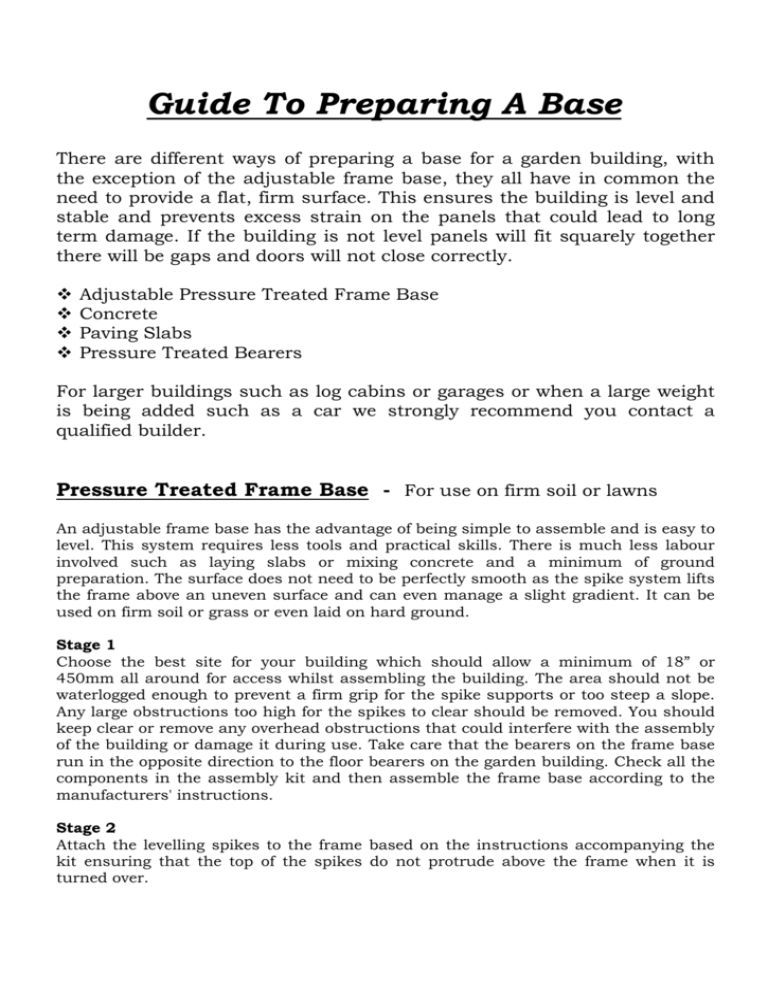Pressure Treated Frame Base - For use on firm soil or lawns
advertisement

Guide To Preparing A Base There are different ways of preparing a base for a garden building, with the exception of the adjustable frame base, they all have in common the need to provide a flat, firm surface. This ensures the building is level and stable and prevents excess strain on the panels that could lead to long term damage. If the building is not level panels will fit squarely together there will be gaps and doors will not close correctly. Adjustable Pressure Treated Frame Base Concrete Paving Slabs Pressure Treated Bearers For larger buildings such as log cabins or garages or when a large weight is being added such as a car we strongly recommend you contact a qualified builder. Pressure Treated Frame Base - For use on firm soil or lawns An adjustable frame base has the advantage of being simple to assemble and is easy to level. This system requires less tools and practical skills. There is much less labour involved such as laying slabs or mixing concrete and a minimum of ground preparation. The surface does not need to be perfectly smooth as the spike system lifts the frame above an uneven surface and can even manage a slight gradient. It can be used on firm soil or grass or even laid on hard ground. Stage 1 Choose the best site for your building which should allow a minimum of 18” or 450mm all around for access whilst assembling the building. The area should not be waterlogged enough to prevent a firm grip for the spike supports or too steep a slope. Any large obstructions too high for the spikes to clear should be removed. You should keep clear or remove any overhead obstructions that could interfere with the assembly of the building or damage it during use. Take care that the bearers on the frame base run in the opposite direction to the floor bearers on the garden building. Check all the components in the assembly kit and then assemble the frame base according to the manufacturers' instructions. Stage 2 Attach the levelling spikes to the frame based on the instructions accompanying the kit ensuring that the top of the spikes do not protrude above the frame when it is turned over. Stage 3 Turn over the frame and put in place. Tap home the levelling spikes in to the ground. Check they are level with a spirit level. For slight unevenness tap home the spikes a little further. For bigger adjustments dig out a small amount of turf or soil from under the circular support plate on the spike or insert some packing. Recheck the frame with the spirit level including across the corners and repeat the process until you sure the frame is level. The base is then ready for your new garden building. Materials and tools required Tape measure Sand paper Gloves Battery powered drill/screwdriver 6mm drill bit Spirit level Rubber mallet or standard hammer with a piece of timber to protect the base Concrete Stage 1 Choose the best area for the site of the building, which should be as level as possible to reduce levelling work later. It should give access all round (a minimum 18” or 450mm) for use during the fitting process. Pegs and string should be used to mark out the base area which should be the same measurements as the floor area of the building (including the veranda if applicable) plus the thickness of the timber used in the formwork for the concrete. To make sure the area is square measure the diagonals. Stage 2 If the base is to go on soft ground or lawn it needs to be dug out following the string lines. To make the base level with the ground surface the hole needs to be 6” or 150mm deep. This is because 3” or 75mm depth of concrete is recommended and this should lay on a 3” or 75mm bed of compacted hardcore. If you prefer to have a step up to the building with the concrete slab standing proud of the ground the hole needs to be excavated to a depth of 3” or 75mm for the compacted hardcore to come level with the surface. The formwork then needs to be set on top of this to give the required 3” or 75mm depth of concrete. You may wish to do this if the area is prone to forming deep puddles in heavy rain or if you feel rain will splash dirt from the surface on to the building. Even the soil at the bottom of the hole with a spade and rake. You may now remove the pegs and string. Stage 3 Make the formwork by measuring, cutting and fitting timber of the right width to provide the depth of concrete you wish (min 150mm) and check the diagonals to ensure the frame is square. Place the formwork in the hole. The top of the formwork must be level to ensure the finished surface of the concrete is level. Spread a layer of hardcore to the 3” or 75mm depth and ensure well compacted. Even off the surface by covering with a layer of sand. Stage 4 Mix the concrete by either 1 part cement powder to 5 parts ballast or you can use bags of dry mix concrete to which you just add water. The concrete should be on the dry side and not too sloppy so mix by adding a small amount of water at a time. The concrete should then be spread over the sand/hardcore evenly until it is slightly above the top of the formwork. Then using a straight edged piece of timber level the concrete to the top of the formwork. This should be done by laying the edge of the timber right across the formwork and then dragging it across the surface of the wet concrete. The best results are obtained by using a sawing motion with the piece of timber as it is dragged across. Preferably prepare the base when dry conditions are expected but if wet conditions are expected cover the concrete with polythene for 24 hours. On hot days to prevent cracking by rapid shrinkage cover the concrete in base with damp sacks and sprinkle them with water occasionally for 24 hours but do not saturate them. Allow a minimum of 48 hours to dry completely and then your new base is ready for your garden building to be installed. Materials and tools required Hardcore Sand Standard cement powder Sand/gravel ballast OR Dry mix concrete bags Water Tape measure Pegs and string Spade Timber for formwork Spirit level Broom Cement mixer Spot mixing board Wheel barrow Tamp board Straight edge section of timber (long enough to go across formwork) Paving Slabs Stage 1 Site the base in a suitable area as in Stage 1 of the concrete base above. Mark out the base area with pegs and string, which should be the same as the base area of the building including the veranda if applicable. Measure the diagonals to check the corners are square. Stage 2 For standard slabs dig out the topsoil from the area to a depth of 2.5” or 70mm and ensure the resulting surface is level. The pegs and string may now be removed. Stage 3 Using 1 part cement to 8 parts building sand to form a dry sand/cement mix. Spread this evenly to a depth of 1.5” or 40mm approx. and use a rake to level it off. Stage 4 Lay the first slab in 1 corner and tap it down in the centre using a rubber mallet. With a spirit level check it is level. If not, tap the relevant side or corner and recheck until correct. Lay the other slabs outward from this first, levelling in the same way as the first slab with the mallet and check the slabs are also level with each other. For best results lay the slabs 1-3mm apart but keep the spaces even. An aid to this would be to put spacers of the correct thickness between the slabs till they are in position and then remove them. To keep the edges of the slabs in line you could use the pegs and string to give you a straight edge to work to. Stage 5 Check the finished base is level with a long straight edge from corner to corner and measure across the diagonals to check it is square. Put some of the dry sand/cement mix on to the slabs and using a broom brush it in to the gaps between the slabs. Brush away any excess sand/cement mix from the surface of the slabs and your base is ready for your new garden building. Materials and tools required Flat face paving slabs Sharp sand Standard cement powder Tape measure Pegs and string Spade Rake Rubber mallet Spirit level Spacers Broom Long straight edge such as apiece of timber Pressure Treated Bearers Stage 1 As for Stage 1 of the concrete base choose your site allowing space for access all around and suitably level. Using your pegs and string mark out the area the same as the base of your garden building including the veranda if applicable. Check the corners are square by measuring the diagonals. Stage 2 Strip the topsoil or turf to a depth of approx. 3” or 75mm and then level the area with a spade. You may now remove the pegs and string. Stage 3 Fill the area with hardcore and compact down ensuring the surface is as level as possible. Spread a thin layer of sand over the surface and level with a rake. Stage 4 Before laying the treated bearers on the surface you must check the direction the floor joists of your new building. The bearers must be laid crossways (90 degrees) to the floor joists. After you have checked this begin to lay the bearers on to the sand. They should be a maximum of 24” or 600mm apart. Check the bearers are level with a spirit level and, if necessary, tap the bearers down with the rubber hammer before checking again with the spirit level. When all the bearers are level the base is ready for your new building. Materials and tools required Hardcore Sand 3” x 3” (75mm x 75mm) Pressure Treated Bearers Tape measure Pegs and string Spade Spirit level Rubber mallet







